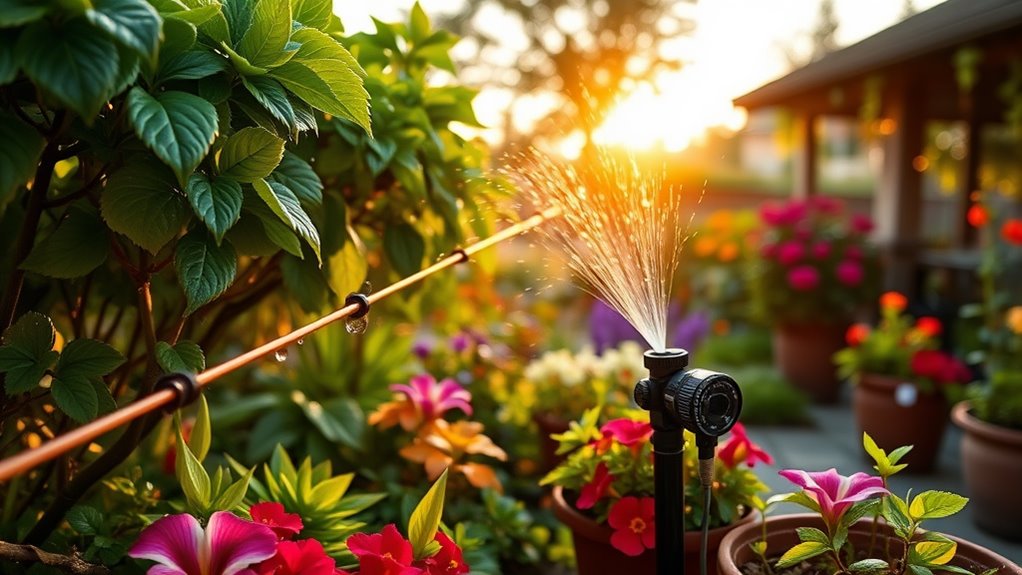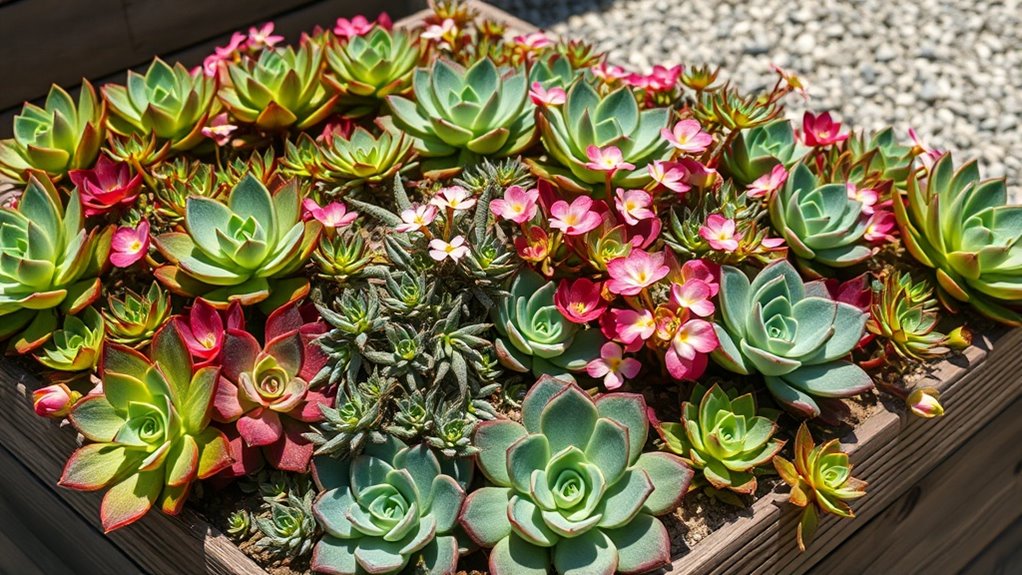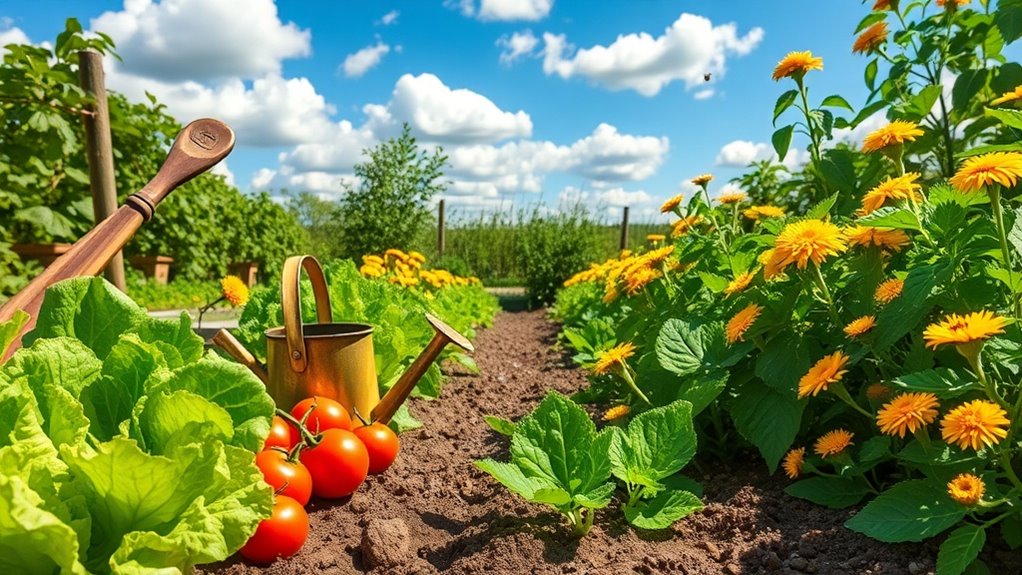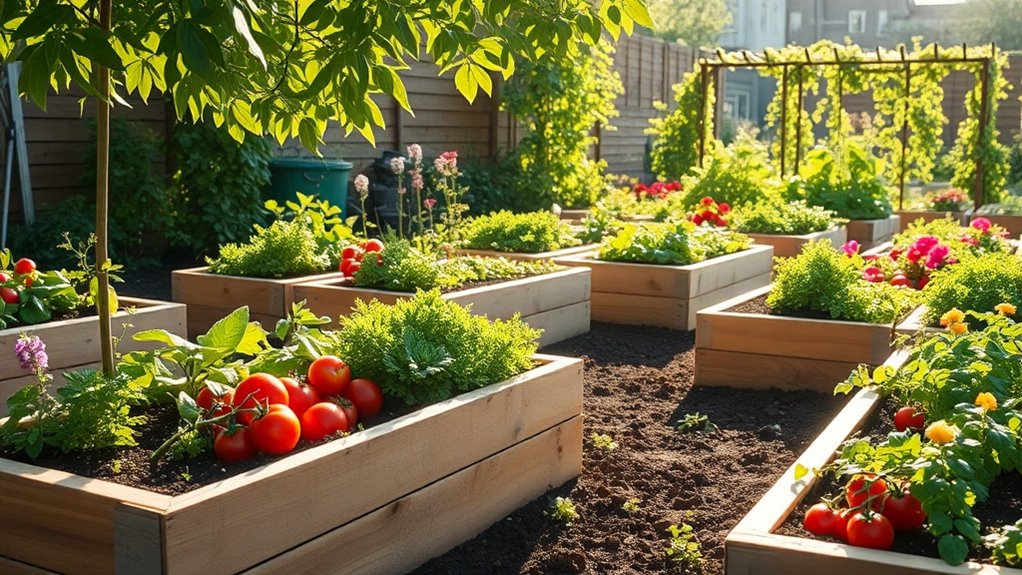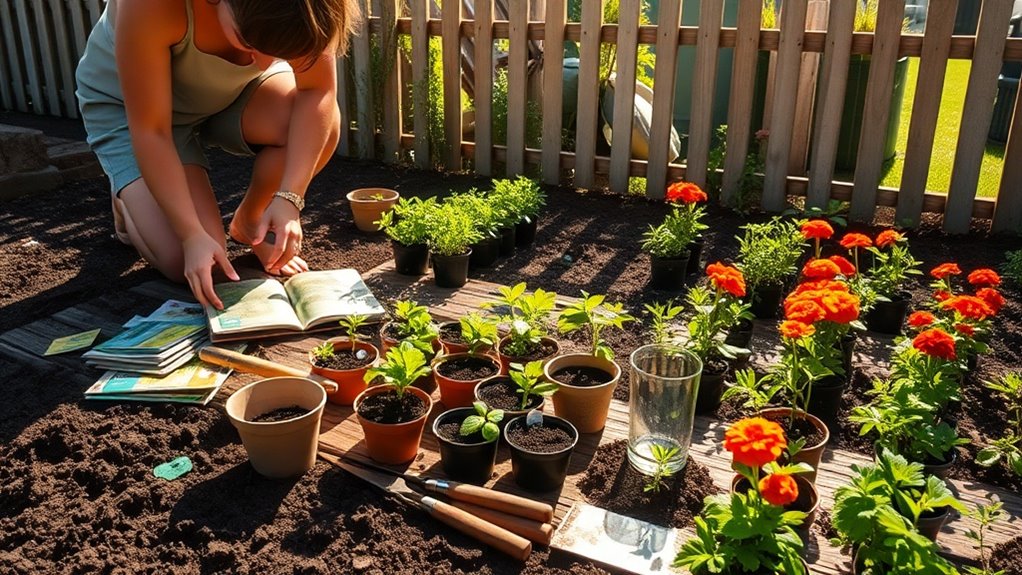How I Keep My Garden Alive During Vacation – Stress-Free Tips
You’ll keep your garden thriving during vacation by automating watering with smart timers and sensors for precise moisture. Choose hardy, drought-resistant plants and group them by water needs to simplify care. Enlist a reliable neighbor with clear instructions, and prep by mulching to retain soil moisture while checking for pests. Monitor weather forecasts for any surprises. Dive into these tips for even more effortless garden maintenance.
Key Takeaways
- Set up an automated watering system with timers to ensure plants stay hydrated without daily attention.
- Choose drought-resistant plants and group them by water needs for low-maintenance care.
- Enlist a trusted neighbor with detailed instructions, including schedules and emergency contacts.
- Prune plants and inspect for pests in advance to promote healthy growth during your absence.
- Apply mulch around plants to retain moisture and suppress weeds for effortless protection.
Automating Watering Systems
If you’re heading out on vacation, setting up an automated watering system ensures your garden thrives without daily attention.
You’ll choose from options like drip irrigation or smart timers, which deliver precise moisture based on your plants’ needs. For watering on vacation, install a reliable timer that activates sprinklers or hoses at set intervals, conserving water while preventing over- or under-hydration.
Test the system beforehand to avoid leaks, and adjust settings for weather forecasts. This practical setup keeps roots hydrated, promoting healthy growth so you return to a vibrant garden, stress-free and flourishing. Additionally, applying expert watering techniques can help optimize your system’s performance for even better results.
By incorporating DIY watering hacks, you can further reduce the time spent on garden maintenance each week for thriving plants.
Selecting Hardy Plants
When choosing hardy plants for your garden, especially before a vacation, focus on varieties that tolerate neglect, such as drought-resistant succulents or native perennials that thrive with minimal water. You’ll evaluate factors like your climate zone and soil conditions to ensure resilience. Opt for plants that require little intervention, reducing vacation worries. Incorporating low-effort plants can simplify your gardening experience even further. Additionally, incorporating resilient herbs from various low-maintenance options can enhance your garden with easy-to-grow flavors.
| Plant Type | Key Benefits | Maintenance Tips |
|---|---|---|
| Succulents | Withstand drought easily | Water every 2-3 weeks |
| Native Perennials | Adapt to local weather | Mulch annually for moisture |
| Ornamental Grasses | Tolerate poor soil and wind | Trim dead growth in spring |
| Drought-Tolerant Shrubs | Low water needs; pest-resistant | Fertilize once yearly |
This approach keeps your garden thriving effortlessly.
Enlisting Neighbor Assistance
When you’re heading out on vacation, you’ll need to choose reliable neighbors who can reliably check on your garden and handle any issues that arise.
Be sure you provide them with clear, detailed care instructions, including watering schedules and pest monitoring to prevent problems.
This approach ensures your plants stay healthy and gives you peace of mind while you’re away. For added reliability, you can suggest incorporating smart gardening tools to help with efficient monitoring and care.
To make garden care even easier, consider incorporating automated systems as a backup for consistent watering.
Choose Reliable Neighbors
One of the most effective ways to protect your garden while you’re away is to choose a reliable neighbor who can handle watering, weeding, and monitoring for issues.
Start by evaluating potential helpers based on trust and capability, ensuring your peace of mind during your break.
To evoke that comforting sense of security:
-
Gauge their reliability: Recall if they’ve shown responsibility before; it’ll warm your heart knowing your garden’s in safe hands.
-
Observe their enthusiasm: Watch for genuine interest in your plants; this builds emotional connection and eases your worries.
-
Foster open communication: Share your needs clearly from the start; it creates a bond that leaves you feeling supported and stress-free.
Provide Care Instructions
Once you’ve selected a trustworthy neighbor, prepare detailed care instructions to guide them effectively. Start by listing plants with their watering needs, pest checks, and weeding tasks. Include schedules, tools required, and emergency contacts for clarity. Be precise about soil moisture levels and any special fertilizers. To visualize key elements, here’s a quick reference table:
| Task | Frequency | Instructions |
|---|---|---|
| Watering | Every 2-3 days | Check soil; apply 1 inch water |
| Pest Monitoring | Weekly | Inspect leaves; use soap spray |
| Weeding | As needed | Pull gently around plant bases |
This approach ensures your garden thrives without issues.
Prepping the Garden in Advance
Before you head out on vacation, you’ll want to set up an automatic watering system to ensure your plants stay hydrated without daily attention. Remember to monitor for signs of overwatering to prevent potential damage while you’re away.
Prune your plants early to encourage strong growth and minimize any potential issues while you’re away.
Don’t forget to check for pests thoroughly, removing any signs to protect your garden from infestations.
Additionally, to enhance your pest protection efforts, consider reviewing the top five pests that could threaten your plants during your absence.
Set Automatic Watering
To keep your garden thriving while you’re away, set up an automatic watering system as a reliable safeguard. This setup ensures consistent moisture, using timers, drip lines, or smart devices tailored to your plants’ needs. Choose systems that match your garden’s size for efficiency.
Here’s how it evokes peace of mind:
-
Relieve your worries: Imagine returning to lush, hydrated plants, not parched soil, giving you true vacation freedom.
-
Spark joy in growth: Your garden flourishes effortlessly, evoking pride and delight in its vibrant health.
-
Prevent heartbreak: Spare yourself the sadness of damaged foliage, ensuring every leaf stays lively and green.
Prune Plants Early
Pruning your plants early gives them a head start on thriving without you, so tackle this task a few weeks before your vacation. This allows wounds to heal and redirects energy to robust growth, ensuring your garden stays balanced.
Use sharp, sterilized shears to remove dead, diseased, or overcrowded branches, focusing on perennials, shrubs, and vines. For roses and fruit trees, cut back to promote airflow and prevent legginess.
You’ll minimize stress and encourage vigorous recovery, making your return easier. Remember, precise cuts foster resilience, so don’t rush—plan for optimal results.
Check for Pests
Before you head out on vacation, inspect your garden thoroughly for pests to prevent any infestations from spiraling out of control. This hands-on check spots early threats like aphids or fungal spots, safeguarding your plants’ health and sparing you post-trip stress.
To evoke the emotional toll of neglect and the relief of action, follow these steps:
-
Scan for visible damage****: Look for chewed leaves or webs, stirring urgency to protect your cherished blooms from devastation.
-
Probe hidden areas****: Dig lightly around roots for larvae, evoking anxiety over potential loss and motivating thorough defense.
-
Treat immediately: Apply natural barriers like neem oil, fostering empowerment and the joy of a thriving garden awaiting your return.
Using Mulch Effectively
While mulch serves as a simple yet effective barrier, you’ll find it essential for retaining soil moisture and suppressing weeds during your vacation. This method helps in keeping your garden consistent moisture and thriving throughout the growing season.
Choose organic options like bark or straw for added soil nutrients; apply a 2-4 inch layer around plants, avoiding direct stem contact to prevent rot. This locks in water, reducing evaporation, so your garden thrives without daily watering.
Regularly refresh mulch before leaving to maintain its barrier; it’ll also moderate soil temperature, protecting roots from heat stress.
For best results, pair it with proper bed preparation, ensuring even coverage for maximum efficiency.
Furthermore, mulch aids in pest control by creating a protective layer that deters pests, enhancing your garden’s overall resilience.
Implementing Smart Technology
You can integrate smart technology to automate your garden’s care, ensuring it stays hydrated and healthy while you’re away. These devices, like automated sprinklers and soil sensors, handle watering based on real-time data, minimizing over- or under-watering risks.
To evoke that worry-free peace, consider these emotional benefits:
-
Relieve your anxiety: Smart apps let you monitor moisture levels remotely, giving you instant reassurance that your beloved plants thrive.
-
Ignite excitement: Receive notifications about your garden’s status, turning absence into anticipation of a vibrant return.
-
Spark joy: Return to a flourishing oasis, fostering a deep sense of accomplishment and connection to your green space.
Grouping Plants Strategically
Strategic grouping of plants plays a key role in maintaining your garden’s health during your absence, as it allows for efficient watering and reduces resource waste.
You can categorize your plants by water needs—grouping thirsty ones like tomatoes with ferns, while placing drought-resistant succulents together. This setup lets you use targeted irrigation systems, like drip lines, without overwatering areas. Furthermore, strategic plant pairings can enhance garden health and increase yields by promoting natural pest deterrence.
Measure soil moisture regularly in each group to fine-tune; for instance, position sun-loving plants in brighter spots to minimize evaporation differences.
Additionally, incorporating companion planting can help deter pests and promote overall plant health by strategically pairing plants that benefit each other.
Monitoring Weather Conditions
Monitoring weather conditions is crucial for safeguarding your garden’s health while you’re away, as sudden changes like heatwaves or heavy rains can disrupt your watering plans.
To stay ahead, use reliable tools that keep you connected and informed.
-
Check forecasts daily: Imagine the anxiety of a storm ruining your blooms—set up weather apps to send alerts, easing your worries with timely notifications.
-
Install smart sensors: Picture the heartbreak of wilted plants from unexpected heat—sensors monitor soil moisture and temperature, giving you peace of mind through real-time updates.
-
Plan backups proactively: Envision the relief of knowing your automated systems adjust for rain—create contingency plans to protect your garden, turning potential disasters into triumphs.

